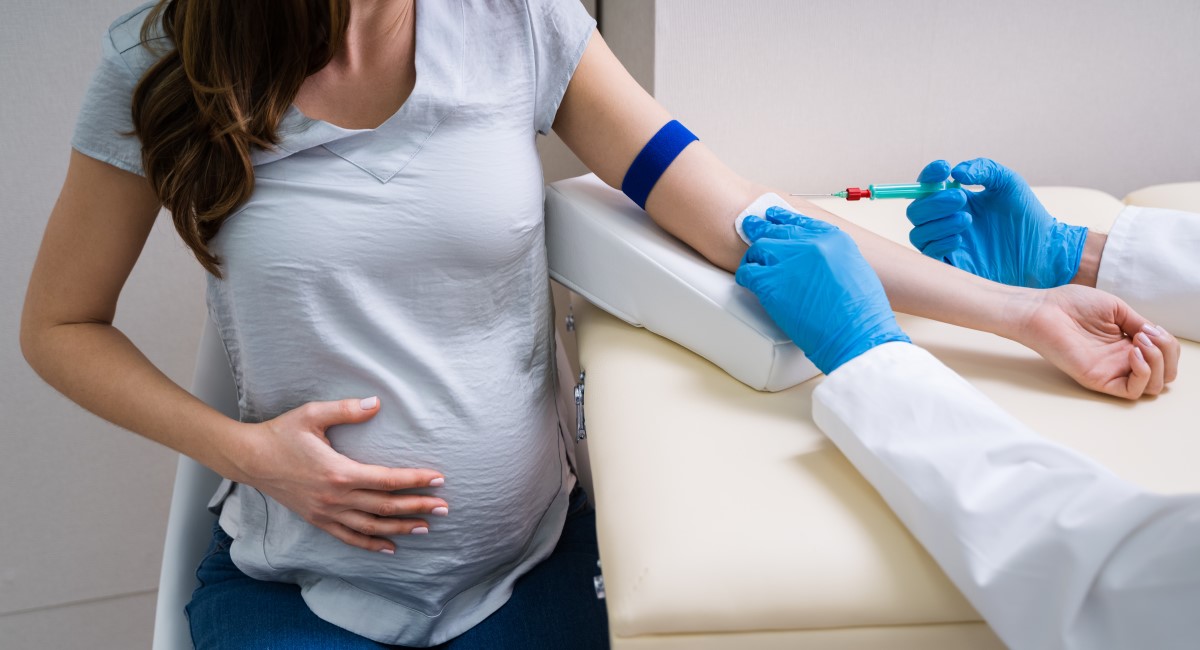“What I say to women when I chat to them is, rather than go to Google and get an answer that’s not specific to your scenario, or makes you absolutely panic, give us a call because we get to know your story and can make the advice relevant to you.”—Nadine Barkay, BumptoBaby midwife, Remedy Healthcare.
Key points
- You should call your GP to schedule a prenatal appointment as soon as you receive a positive pregnancy test.
- Women who have an uncomplicated pregnancy can expect to have 10 to 12 prenatal appointments.
- Australian Unity private health customers with pregnancy cover who have served their 12-month waiting period can access the BumptoBaby program, which is a telephone- and email-based service that gives direct access to midwives.
Whether you’ve seen two lines, a “plus” symbol, or a definitive digital “yes”, a positive pregnancy test can prompt an exciting and overwhelming mix of emotions.
It doesn’t matter if your pregnancy was planned or a total surprise, you’re not alone in thinking “what happens now?” Here we cover the next steps and the appointments you can expect from that positive result right through your pregnancy and just after the birth.

What to consider in the early stages
According to the Department of Health, women who have an uncomplicated pregnancy can expect to have 10 to 12 prenatal appointments. This starts with a prenatal appointment with your GP, says Nadine Barkay, a midwife at BumptoBaby, a program delivered by Australian Unity’s Remedy Healthcare, that provides support and information for expectant parents with eligible cover.
“Once you have received a positive pregnancy test, you always need to book an appointment with your GP. They’ll do some basic checks for you, like checking your blood type, your iron and general blood make-up,” she explains.
“They’ll also check when your last menstrual cycle was so you can know how far along you are. At this point, you might be feeling a bit nauseous but you won’t be getting a bump yet.”
During that first prenatal appointment, your GP will likely order a range of blood tests to check the following:
- your blood group and iron levels
- your immunity to rubella (German measles)
- if you have been previously exposed to hepatitis
- if you have any sexually transmitted infections, such as syphilis or HIV
- thalassaemia (an inherited blood disorder)
- vitamin D levels
Your blood group is checked in early pregnancy for a few reasons but one of them is to see if you have a negative blood type (rhesus negative, or Rh negative). Women with a negative blood type who have a baby with a positive blood type may be at risk of their immune system responding as if the baby’s red blood cells are foreign to their body, producing an antibody to destroy these new cells.
To prevent this from happening, women who have a negative blood type are offered an injection of anti-D immunoglobulin in their third trimester.
In addition to blood tests, your GP may also do or organise the following tests:
- A urine test to check for infection.
- A cervical screening test, if you’re due for one.

Although it’s not a routine test, your doctor may also organise a dating scan, which is an ultrasound to confirm your estimated date of delivery (EDD) and if you’re having a singleton or multiple pregnancy, such as twins.
Once you’ve had your pregnancy confirmed by your GP and had your initial tests, it’s a good idea to give your private health insurance fund a call to discuss your cover, because with pregnancy, a 12-month waiting period applies.
According to Rebecca Doherty, Customer Solutions Team Leader at Australian Unity, during that initial call, your fund should tell you what services you can access.
“We’d ask what hospital you’re planning to give birth at and do a hospital eligibility check to see if we have an agreement with that private hospital,” she explains.
“We’d also ask your obstetrician’s name and check if that particular doctor participates in gap cover. If doctors do participate, this can help reduce out-of-pocket costs.”
Australian Unity private health customers with pregnancy cover who have served their 12-month waiting period can also access the BumptoBaby program, which is a telephone-based service that gives women direct access to midwives.
Rebecca describes BumptoBaby as “an additional support network for mums of any sort. They can connect to us over the phone, even after-hours”.
The service is also available to adoptive and surrogate parents who hold eligible cover
BumptoBaby midwife Nadine says the service is a source of support and advice and also acts as a great alternative to “Dr Google”.
“What I say to women when I chat to them is, rather than go to Google and get an answer that’s not specific to your scenario, or makes you absolutely panic, give us a call because we get to know your story and can make the advice relevant to you.”
BumptoBaby can also provide advice on what you can and can’t do during pregnancy, including information on food, exercise and household duties. And, says Nadine, while some things are off the cards for now—including eating raw fish and cleaning your cat’s litter—other things, like a slightly modified form of your favourite exercise, are encouraged.

First trimester appointments
The first trimester of pregnancy runs from conception to 12 weeks.
Once you’ve had your first prenatal visit and relevant initial tests as described above, you will have appointments with your GP and/or obstetrician approximately every two to six weeks, depending on your circumstances.
You will be offered an ultrasound scan at 11 to 13 weeks (often called the “12-week scan”). Similar to the dating scan, this checks whether you’re carrying a single baby or multiple, and confirms your estimated due date; it also reviews the baby’s anatomy.
In conjunction with a blood test, the 12-week scan can also screen for some common chromosomal conditions; this is called the combined first trimester screening (CFTS).
Alternatively, at 10 weeks, you have the option of having the Non-Invasive Prenatal Test (NIPT), sometimes called the Harmony or NEST test, which is a highly sensitive blood test that can screen for Down Syndrome and other genetic conditions.
“It’s an out-of-pocket cost,” explains Nadine. “It takes blood from the maternal circulation as there’ll be some foetal cells in there in which they can check for genetic abnormalities.
“So you’ll know very early on that the baby is genetically well, and they can also tell you— which is the bit most people love—the sex of your baby.”
Second trimester appointments
The second trimester of pregnancy runs from 13 to 26 weeks.
During your second trimester, you’ll see a doctor or midwife every two to six weeks. You can expect some milestone appointments and tests, including:
- At each check-up: You will have your blood pressure and baby’s heartbeat checked, and your fundal height (size of your stomach) measured. You may also be offered blood and urine tests.
- 14 weeks onwards: Most doctors recommend women get a flu vaccine, which will help protect the baby against the flu.
- 16 to 17 weeks: In the public system, you usually have your hospital booking-in appointment, where you discuss your birth plans with a midwife, who will also assess factors such as your mental health and lifestyle; they may refer you to other health professionals such as a psychologist, dietitian or physiotherapist.
- 18 to 20 weeks: You’ll undergo a morphology scan—often called the “20-week scan”. It’s a comprehensive ultrasound that looks at your developing baby in detail. You may also choose to find out your baby’s sex at this scan.
- 20 weeks onwards: Women are encouraged to get a whooping cough vaccine.
- 24 to 28 weeks: You will be offered a glucose tolerance test (GTT), which checks for gestational diabetes.

Gestational diabetes is something to watch out for in your second trimester. According to Diabetes Australia, 12 to 14 percent of pregnant women will develop it at around 24 to 28 weeks.
But, if you do test positive for gestational diabetes or develop any other complications that deem your pregnancy “high risk”, Nadine has some words of reassurance.
“I’ve had lots of women that have been high risk for different reasons,” she explains. “Whether it’s physical, such as the placenta not being in a great place, or this is their fourth pregnancy after miscarriages and they’re nervous. High risk doesn’t always mean uncommon; it’s just that there’s a little bit of a higher risk and we want to keep an eye on things.”
Third trimester appointments
The third trimester of pregnancy runs from 27 to 40 weeks.
During your third trimester, you can expect to have frequent prenatal check-ups (typically every two to three weeks until 36 weeks, and then weekly or fortnightly checks), as well as some milestone appointments and tests. These include:
- At each check-up: You will have your blood pressure and baby’s heartbeat checked, and your fundal height (size of your stomach) measured. You may also be offered blood and urine tests.
- 35 to 37 weeks: You will be offered a swab test for Group B streptococci (GBS), a type of bacteria that, in a very small number of cases, can pass to your baby during birth and cause an infection. If you have GBS, you will offered antibiotics during labour to reduce this risk.
- From 36 weeks: Routine checks for the position of the baby’s head in your pelvis, their heartbeat and pattern of movements.

This is a busy trimester filled with appointments, planning and nesting—as well as your prenatal appointments and tests, you may have childbirth education classes, a hospital tour or any other classes you choose to take, such as breastfeeding classes or a first-aid course. It’s also a great time to lean on BumptoBaby, especially if you have questions that you forgot to raise with your doctor.
“Often the doctor will give you things to do or think about, and if you want to chat through them, we can explain it,” says Nadine.
“Also, doctors often use terms you might not know, like ‘induction’ or ‘augment’ and a lot of people may nod along because they’re overwhelmed or unsure and then they ring us and say ‘what does that actually mean?’”
Now is also a good time to supply your private health insurance provider with the finer details about who your delivery doctor is and how they’ll charge, says Rebecca.
“This will also determine how our members can claim from us,” she explains, adding, “We also ask you get an informed financial consent, which outlines in detail all the different item numbers, what’s covered by your health fund and by Medicare, and if there’s any out-of-pocket costs.”
Fourth trimester appointments
Your baby is here—congratulations! The first three months after your baby is born is often referred to as the “fourth trimester”, and while the transition from being pregnant to a parent can be a tricky one, help is available.
“I remind people that the first three months, that fourth trimester, are a total write-off,” says Nadine.
“Have no expectations and you’ll be happy. Kids will sort themselves out, you will sort yourself out. It’s a whole new life change, so don’t judge what you do in the first three months as what kind of parent you’re going to be for the rest of your life.
“Do what you need to do to survive. The first three months are hard and challenging—rewarding and wonderful—but still, be kind to yourself.”
While you’ll likely have a number of tasks on your new-baby admin list, it’s important to get in touch with your private health insurer fairly soon after birth, both to put your baby’s name on your policy and also to make sure you can access any postnatal health services you may need.
“We ask that people give us a call as soon as possible to avoid any waiting periods for the child,” explains Rebecca.
“Also, it helps to check if your cover includes additional services you may need for postnatal difficulties, like the establishment of breastfeeding, exhaustion, reflux, and sleeping difficulties. However, access is dependent on prior approval, having the right cover and passing any relevant waiting periods.”

During your fourth trimester, some of the milestone appointments and tests you can expect include:
- Five- to 10-day postnatal check: Your doctor or midwife will check your initial recovery after birth, how breastfeeding is going (if you’ve chosen to do so), and will perform routine health checks, such as measuring your blood pressure.
- Six-week postnatal check: This appointment with your doctor will check that both you and your baby are well. It may include a cervical screening test (if this is due), blood tests and/or an internal examination.
According to Nadine, it’s best not to worry too much about your postnatal appointments as “they’ll kind of be done for you” and made by your doctor or hospital once you’ve delivered your baby.
Instead, she advises to connect with your local council. “The council will plug you into parents’ groups and into immunisation routines,” she explains.
Her other big tip? Keeping in touch with BumptoBaby, of course. “The lovely thing about Australian Unity is that we can make referrals,” she explains. “So, say someone needs support for their mental health, we can refer them to our MindStep program. It’s a telephone-based service with a psychology specialist that provides ways to help people manage their anxiety and gives them tips on what to do and how to make it better.
“The other thing we can refer is a dietitian, so if you’re low in iron for example, have a specific diet or gestational diabetes, then you can get advice on what to eat.”
But staying in touch isn’t all about the customer, admits Nadine. “The BumptoBaby midwives all love to keep in touch with the pregnant women they have supported. It’s so lovely, it means we can follow them from pregnancy through to them having a one-year-old baby,” she says.
Disclaimer: Information provided in this article is of a general nature. Australian Unity accepts no responsibility for the accuracy of any of the opinions, advice, representations or information contained in this publication. Readers should rely on their own advice and enquiries in making decisions affecting their own health, wellbeing or interest. Interviewee titles and employer are cited as at the time of interview and may have changed since publication.


